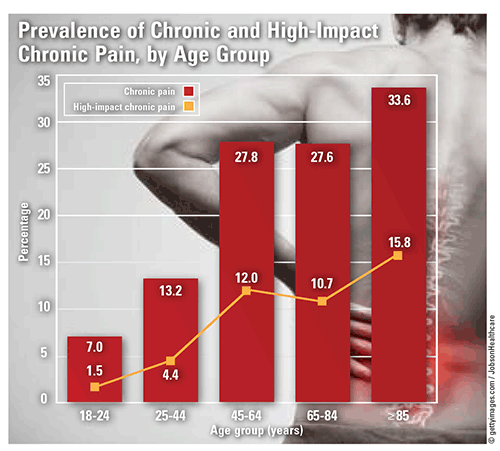US Pharm. 2019;44(3):12.
According to the 2016 National Health Interview Survey, chronic pain that does not limit major life activities (20.4% prevalence, 50 million adults) and pain that frequently limits major life activities, or high-impact chronic pain (HICP; 8% prevalence, 19.6 million adults), have been linked to various physical and mental conditions. About 83% of adults with HICP were unable to work, and one-third had difficulty with self-care activities such as washing and dressing. HICP adults had higher levels of anxiety, depression, fatigue, and cognitive difficulty and reported more severe pain, worse health, and greater use of healthcare services.

Age, Sex, and Race: The prevalence of chronic pain and HICP increased progressively with age. Chronic-pain prevalence rose steadily for age groups 18 to 24 years, 25 to 44 years, and 45 to 64 years, then leveled off in persons aged 65 to 84 years before increasing in those aged ≥85 years. HICP prevalence followed a similar path. Women experienced more chronic pain (20.8%) and HICP (8.2%) than men did (17.8% and 6.7%, respectively). Non-Hispanic whites had the highest prevalence of chronic pain (21%), followed by non-Hispanic blacks (17.8%), Hispanics (16.7%), and other non-Hispanics (14.4%). For HICP, however, non-Hispanic blacks had the highest rate (8.1%), followed by Hispanics (7.9%), non-Hispanic whites (7.4%), and other non-Hispanics (7%).
Education, Employment, and Economic Status: In adults who earned a bachelor’s degree or higher, the prevalences of chronic pain (12.4%) and HICP (3.5%) were lower than in adults whose educational level was less than a high school degree (23.7% and 12.1%, respectively). Adults who were not employed but had worked previously experienced more chronic pain and HICP (29.2% and 16.1%, respectively) compared with those who were employed (14.5% and 3.2%, respectively). Among veterans, chronic pain was more prevalent (26%) than HICP (19%), and the prevalence of HICP was 4% higher among nonveterans (22.7%). The prevalence of chronic pain and HICP was higher among persons who were economically deprived (29.6% and 17.5%, respectively) than among those who were financially better off (14.6% and 3.9%, respectively). The prevalence of chronic pain relative to HICP was 274% higher in those who were financially better off compared with those who were economically deprived (69.1%).
Health Insurance Coverage: Among persons aged <65 years, chronic pain prevalence was lowest in adults covered by private health insurance (14%) and nearly double in those covered by Medicaid or other public programs (30%). By contrast, the prevalence of HICP was about five times greater between the two types of coverage (3.8% vs. 17.8%, respectively).
To comment on this article, contact rdavidson@uspharmacist.com.






